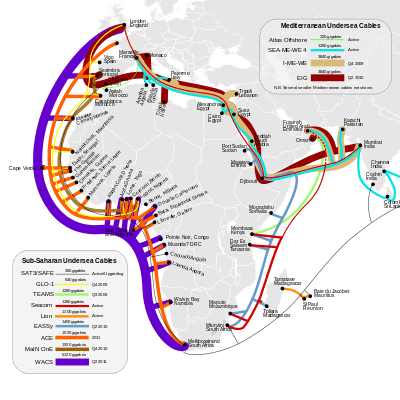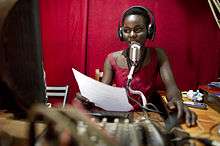Telecommunications in Sudan
Telecommunications in Sudan includes fixed and mobile telephones, the Internet, radio, and television.
Pre-privatization era (up to 1994)
Sudan had telecommunication services as early as 1897. All of the organizations established to deliver telecommunications services were government-owned. They were, for all practical purposes, entities with little or no operational and financial autonomy and little control over their own destiny. Despite many development plans and efforts, the state of telecommunication sector in the country remained extremely poor through 1994. At that time, Sudan had one of the lowest penetration rates (0.23%) even by regional standards.
Privatization era (1994 and beyond)
The Three-Year Economic Salvation Programme (1990–1993), adopted by the Government of Sudan, emphasized the role of telecommunications in the socio-economic development process and called for the removal of the monopolistic environment in the sector and for the involvement of the private sector—whether local or foreign—in the telecommunication sector as well as in other sectors to overcome the persistent shortfalls in investment and performance. As an outcome of this programme, the structure of the telecommunication sector in the country at present is as follows:
- a) The Ministry (Ministry of Information & Communications): in charge of policies and legislation.
- b) The Regulator (National Telecom Corporation, NTC): in charge of regulatory functions.
- c) The licensed operators and service providers: in charge of the operation of licensed networks and of the provision of services.
The liberalization and privatization of the telecommunication sector, the policies, the regulations and plans adopted by the Government of the Sudan have created a capital–attracting, pro-competitive policy environment that have fostered the build–up of a modern, fully–digital infrastructure in the country and furnished a climate suited to enhance Information and communications technology (ITC) development nationwide. The transformation and achievements witnessed in the Sudanese Telecommunication sector coupled with the growing and diversifying use of the ITC services including those of the Internet and its applications have made Sudan to be widely held among the most developed in Africa, if not in the Middle East. But the market is still considered to be virgin and huge investment opportunities exist and shall explode with the full realization of peace and stability throughout the country.[1]
- Providers
Operator/service provider Date of licence Technology Network Capacity Country wide Coverage Subscribers Zain Sudan 14 August 1996 3.5G (GSM and WCDMA)+ 4G Unknown 120 locations 12,000,000+ MTN Sudan 25 October 2003 3G+ (GSM) 1,100,000 35 locations 1,788,237 Sudani One 2 February 2006 3.75G (CDMA) 4,000,000 145 locations 3,000,000 Canar Telecommunications April 2005 3G (CDMA) Unknown unknown unknown
Evolution of the telecommunication sector (1994 to September 2006)
- Fixed Services
SUDATEL 19 April 1993 TDM/MPLS 1,493,674 200 locations 411,000 CANAR (Limited Mobility) 11 October 2004 IP-MPLS/CDMA 250,000 5 locations 104,720
- Growth of fixed and mobile communications
1994 2000 2004 2005 2006 Fixed Capacity x 1000 150 416 1500 1500 1500 Subscribers x 1000 64 386 1929 680 515 Mobile Capacity x 1000 — 20 1250 2000 4800 Subscribers x 1000 — 1 1050 1866 3370
Telephones

- Calling code: +249[2]
- International call prefix: 00[3]
- Main lines: 425,000 lines in use, 101st in the world (2012).[2]
- Mobile cellular: 27.7 million, 38th in the world (2012).[2]
- Domestic: well-equipped system by regional standards that is being upgraded; cellular communications started in 1996 and have expanded substantially with wide coverage of most major cities, microwave radio relay, cable, fiber optic, radio telephone communications, tropospheric scatter, and a domestic satellite system with 14 earth stations (2010).[2]
- Communications cables: EASSy and FLAG / FALCON fiber-optic submarine cable systems (2010).[2]
- Satellite earth stations: 1 Intelsat (Atlantic Ocean), 1 Arabsat (2010).[2]
Internet
- Internet users: 7.2 million users, 46th in the world; 21.0% of the population, 142nd in the world (2012).[4][5]
- Fixed broadband: 18,472 subscriptions, 131st in the world; 0.1% of population, 172nd in the world (2012).[4][6]
- Wireless broadband: 5.6 million subscriptions, 31st in the world; 16.4% of the population, 78th in the world (2012).[7]
- Internet hosts: 99, 211th in the world (2012).[2]
- IPv4: 283,904 addresses allocated, less than 0.05% of the world total, 6.3 addresses per 1000 people (2012).[8][9][10]
- Top-level domain: .sd[2]
No Internet services were available before 1996.
As of 2006 Internet services were available via:
- Dial-up: 56/230 kbit/s
- Frame Relay: 2 Mbit/s
- DSL: 4 Mbit/s
Licensed providers of value-added services:
- Internet service providers: 22
- Pre-paid telephone cards: 17
- Voice mail: 1
- IVR/SMS: 47
- Automatic vehicle location (AVL): 3
- Technical support: 3
International and regional connectivity:
- ARABSAT 1468 circuits, Arab World
- MIDNET 60 circuits, Africa
- INTELSAT 398 circuits, international
- BT E/S 180 circuits, Internet
- Submarine system-SAS 149 systems, international (*)
- Optic fiber link 60 circuits to Ethiopia
- Optic fiber link 240 circuits to Egypt
(*) One system equals 30 circuits.
Internet censorship and surveillance
Sudan was listed as engaged in substantial Internet filtering in the social and Internet tools areas, in selective filtering in the political area, and as no evidence of filtering in conflict/security area by the OpenNet Initiative in August 2009. Sudan openly acknowledges filtering content that transgresses public morality and ethics or threatens order. The state's regulatory authority established a special unit to monitor and implement filtration; this primarily targets pornography and, to a lesser extent, gay and lesbian content, dating sites, provocative attire, and many anonymizer and proxy Web sites.[11]
The government monitors Internet communications, and the National Intelligence and Security Services (NISS) reads e-mail messages between private citizens. The National Telecommunications Corporation blocks some Web sites and most proxy servers deemed offensive to public morality. While there generally are no restrictions on access to news and information Web sites, authorities regularly block access to YouTube. During the June and July 2012 antigovernment demonstrations, authorities blocked access to several popular online discussion forums. Security agencies also arrested several bloggers during this period, and commentators speculated the government used social media to track and arrest protesters.[12]
The interim national constitution provides for freedom of thought, expression, and of the press “as regulated by law”; however, the government severely restricts these rights. Individuals who criticize the government publicly or privately are subject to reprisal, including arrest. Journalists are subjected to arrest, harassment, intimidation, and violence due to their reporting. The government, including NISS, practices direct prepublication censorship of all forms of media. Journalists also practice self-censorship. NISS resorts to legal action against journalists, bringing libel lawsuits for stories critical of the government and security services. The Supreme Court in December 2011 overturned a lower court decision against several of the accused journalists, but NISS petitioned for a review of the higher court's decision. The Supreme Court rejected the NISS appeal in September 2012, but the security service continued to pursue defamation cases against several other journalists. The interim national constitution and law prohibit arbitrary interference with privacy, family, home, or correspondence, but the government routinely violates these rights. Emergency laws in Darfur and Blue Nile states legalize interference in privacy, family, home, and correspondence. Security forces frequently conduct searches without warrants and target persons suspected of political crimes. The government monitors private communication and movement of individuals without due legal process.[12]
Information society and universal service support
An ICT Fund has been recently enacted to focus on the support the information society requisites and universal service objectives. Some of the programmes supported by this fund are:
- A computer for every household.
- E-government realization.
- Implementation of multi-purpose telecentres as platforms providing urban, rural and remote areas and businesses with ICT services and applications. Such centers will provide physical access as well as the necessary user support and training to allow effective use and development of ICT applications.
Radio and television

- Radio: directly controlled by the Sudanese Government (2007);[2] a private radio station is in operation (2007);[2] 22 AM and 1 shortwave (HF) broadcast stations.
- Radio sets: 13.7 million.
- TV: directly controlled by the Sudanese Government (2007);[2] 95 broadcast and relay stations.
- TV sets: 6.7 million.
Radio and television broadcasting are operated by the government. Sudan Television operates three stations located in Omdurman, Al Jazirah, and Atbarah. The major radio station of the Sudan National Broadcasting Corporation is in Omdurman, with a regional station in Juba for the south. Some foreign shortwave radio broadcasts are available, and a private FM radio station continues to operate. The government restricts UN radio. In addition to domestic and satellite television services, there is a private cable network that directly rebroadcasts uncensored foreign news and other programs.[12]
The government, including the National Intelligence and Security Services (NISS), continues to practice direct prepublication censorship of all forms of media. TV has a permanent military censor. The government directly controls radio and television and requires that both reflect government policies.[12] Following the 1989 coup, the Revolutionary Command Council for National Salvation (RCC-NS) dismissed several broadcasters from Sudan Television because their loyalty to the new government and its policies was considered suspect.
In opposition to the official broadcast network, the Sudan People's Liberation Army operated its own clandestine radio station, Radio SPLA, from secret transmitters within the country and facilities in Ethiopia. Radio SPLA broadcasts were in Arabic, English, and various languages of the south. In 1990, the National Democratic Alliance began broadcasts on Radio SPLA's frequencies.
Another clandestine radio station, Radio Dabanga, began broadcasting in December 2008 using shortwave transmitters of Radio Netherlands Worldwide. Government-run Radio Omdurman ran jamming signals to attempt to interfere with reception during Radio Dabanga's broadcast times, but these jamming efforts were ineffective, in part because Radio Dabanga used two shortwave frequencies.[13]
See also
- Media of Sudan, includes information on radio, television, and newspapers.
- List of news websites in Sudan
- Sudan TV, Sudan National Broadcasting Corporation (SNBC), government-owned and operated Arabic language national television network.
- Sudatel, a telecommunications and Internet service provider, more than 60% owned by the Sudanese government with the remainder owned by private interests.
References


- ↑ Source: National Telecom Corp. NTC, the ICT regulator.
- 1 2 3 4 5 6 7 8 9 10 11 "Communications: Sudan", World Factbook, U.S. Central Intelligence Agency, 4 December 2013. Retrieved 4 January 2014.
- ↑ Dialing Procedures (International Prefix, National (Trunk) Prefix and National (Significant) Number) (in Accordance with ITY-T Recommendation E.164 (11/2010)), Annex to ITU Operational Bulletin No. 994-15.XII.2011, International Telecommunication Union (ITU, Geneva), 15 December 2011. Retrieved 2 January 2014.
- 1 2 Calculated using penetration rate and population data from "Countries and Areas Ranked by Population: 2012" Archived 2017-03-29 at the Wayback Machine., Population data, International Programs, U.S. Census Bureau, retrieved 26 June 2013
- ↑ "Percentage of Individuals using the Internet 2000-2012", International Telecommunications Union (Geneva), June 2013, retrieved 22 June 2013
- ↑ "Fixed (wired)-broadband subscriptions per 100 inhabitants 2012", Dynamic Report, ITU ITC EYE, International Telecommunication Union. Retrieved on 29 June 2013.
- ↑ "Active mobile-broadband subscriptions per 100 inhabitants 2012", Dynamic Report, ITU ITC EYE, International Telecommunication Union. Retrieved on 29 June 2013.
- ↑ IPv4 address figures include Sudan and South Sudan.
- ↑ Select Formats Archived 2009-05-13 at the Wayback Machine., Country IP Blocks. Accessed on 2 April 2012. Note: Site is said to be updated daily.
- ↑ Population, The World Factbook, United States Central Intelligence Agency. Accessed on 2 April 2012. Note: Data are mostly for 1 July 2012.
- ↑ "ONI Country Profile: Sudan", OpenNet Initiative, 7 August 2009
- 1 2 3 4 "Sudan", Country Reports on Human Rights Practices for 2012, Bureau of Democracy, Human Rights and Labor, U.S. Department of State, 2 April 2013. Retrieved 4 January 2014.
- ↑ "Sudan: Darfur Radio Show Launched - Programme Will Overcome Sudanese Censorship to Deliver News On War Crimes Justice Developments", Institute for War & Peace Reporting, AllAfrica, 29 November 2009. Retrieved 4 January 2014.